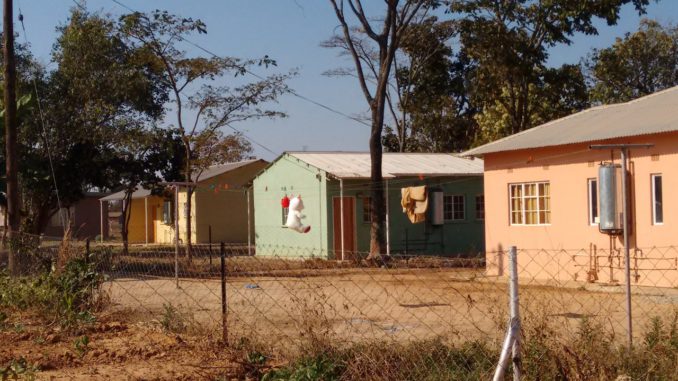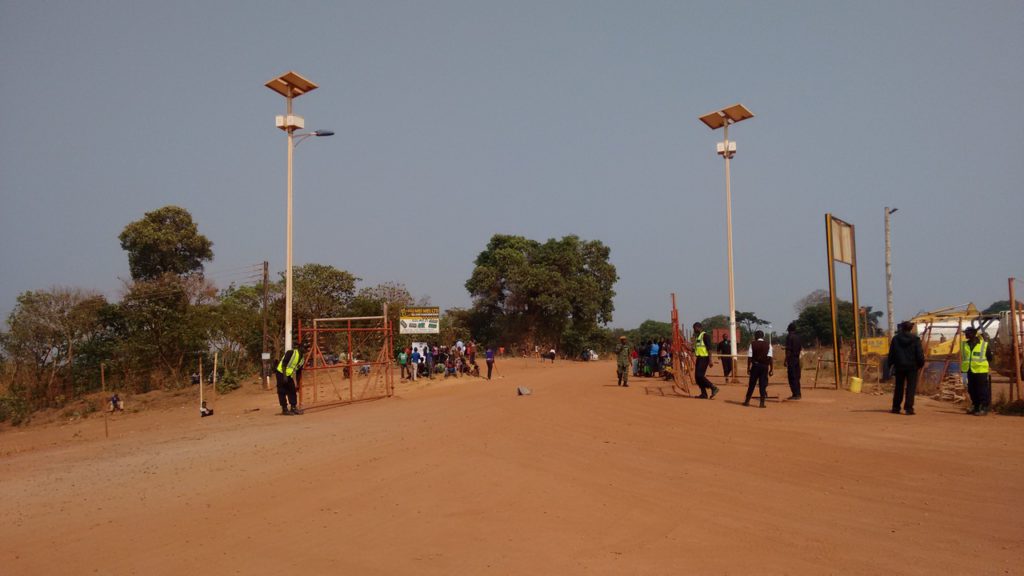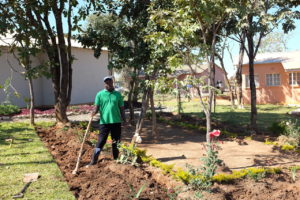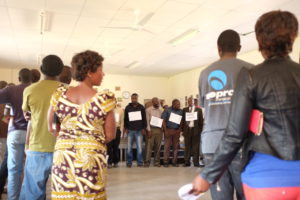
Rita Kesselring is a Senior Lecturer at the Institute for Social Anthropology at the University of Basel in Switzerland. She is the author of the book Bodies of Truth: Law, Memory and Emancipation in Post-Apartheid South Africa (Stanford University Press 2016). Her current research project deals with the ‘new Copperbelt’ in Zambia. She also leads and coordinates the interdisciplinary project Valueworks: Effects of Financialisation along the Copper Value Chain. Read how she describes her research in her own words here.
Solwezi, a bustling mining town in Zambia’s Northwestern Province, is known for its dust (watch a wonderful “dust report” by Muvi TV here), its traffic jams, its chaotic growth and difficult planning processes. Most people live in densely settled and poorly serviced areas, where electricity and public water supply are often inexistent. Imagine a suburb in this town with wide roads, clear boundaries around plots whose single houses each are occupied by one small family, a functioning drainage system, pipe water. The houses, constructed on an architect’s plan, look identical; electric kitchen and bathrooms are placed inside. Instead of foreign trucks, people you know pass by on foot or in private cars, and almost all household heads are in wage employment. You see no stray dogs, hear no loud noises, but can walk on tarred roads and see people watering their little gardens.

Such a suburb, which in many aspects is the opposite to most quarters of Solwezi town, actually exists. The 230 ha Kabitaka Hills Development Project is a housing project planned by the Zimbabwean company ARUP and built and owned by the developer Kabitaka Hills Development Corporation (KHDC), a 100% subsidiary of the Canada-based First Quantum Minerals (FQML). FQML bought the Kansanshi mine north of Solwezi town in 2005 and has since turned it into the largest copper mine on the African continent by output.
Kabitaka, about 10 kilometres east of the Solwezi centre and within the planned expansion of the municipal boundaries, was built for middle class employees at Kansanshi Mine against the background of housing shortage in Solwezi. For some months in 2015, I lived in one of the 642 houses (out of which only 410 are currently occupied) in Kabitaka as parts of my 15 months of field research in the Solwezi area.
The first families moved to Kabitaka in January 2014. My colleague Chibamba Jennifer Chansa, now a PhD candidate at the University of the Free State, South Africa, undertook a household survey between August and September 2015, complementing my more ethnographic approach. The questionnaire we used was inspired by surveys carried out by the Rhodes-Livingstone Institute in the 1940s and 1950s. The number of permanent residents in a house, it emerged, ranged between two and eight. Apart from children, many relatives lived with the families – some permanently, some on a visiting basis. 84 out of the 87 responding families had lived in Solwezi town before moving to Kabitaka. For 80% of the respondents, the place of residence before Solwezi was in one of the Copperbelt towns. Out of the 87 family heads, only five had never lived in the Zambian Copperbelt, and only 12 had not spend their childhood on the Zambian Copperbelt. Like many new Solwezi residents, formerly a rural Kaonde-speaking area, most people in Kabitaka speak Bemba, and are used to living in towns.

We could see this suburb as part of an “enclaving” project, in conjunction with the securitized mining license area and the exclusive golf estate, in which white expatriate workers and senior to middle management of the mine live. According to Hannah Appel, an exclave is a site for the extractive industry to “disentangle the production of profit from the place in which it happens to find itself”. Enclaves are not a given, but emerge through socio-material practices.
Has FQM succeeded in creating such an enclave for its mid-level labour to integrate them more smoothly into the global production network? It is impossible to really answer this question within the space provided here. However, some flashlights into the everyday life of Kabitaka’s residents might suggest that the notion of an enclave is too close to the planners’ perspective to help us unravel the dynamics of corporate governance and people’s place-making at sites of extraction.
As ideal and idyllic as Kabitaka might look at first sight, when you stay there for a while, you learn about people’s grievances and complaints, and start seeing a number of things that defeat the developers’ plans.

In a protracted process, the mine received the consent to use the land from the acting Chief Kapijimpanga, and had the land changed from customary to lease tenure by the local government and the Ministry of Lands. Only very recently, the Solwezi Municipal Council has started to formalize the individual plots. Without security of tenure, investors have been reluctant to build, and the zone planned for shops lies idle.
Due to the lack of shops on site, Kabitaka is not self-contained; quite the contrary. To purchase goods, residents travel the ten kilometres to the mitec market at the entrance of Solwezi, or even further to Shoprite or two new malls in Solwezi town. Also, the lack of shops has triggered the emergence of informal activities on the Kabitaka premises. A great number of households have specialized on selling a specific good from their back door: airtime, bred, rice, mealie meal, beer, peanut butter, and tomatoes. To top up, almost everybody has a little garden on the plot growing rape, onions, tomatoes, Chinese cabbage, kalembula (sweet potato leaves) or chibwabwa (pumpkin leaves), and some have a pigeon or a chicken house.

Although residents are called “homeowners” and although the aim of the project was to offer affordable homeownership, they still rent the houses from KHDC more than three years into the project. KHDC has not managed to set up an affordable mortgage system and tells residents that they “rent to buy”. Residents are suspicious whether this is the case; and incidents of non-inheritance after the death of the homeowner have proven them right. For employees, the rent represents about 40% of their gross salaries; people who do not live on the Kabitaka premises receive the equivalent as a living-out allowance. In addition to the high rent compared to prices in Solwezi town, many families straddle at least two households, one on the Copperbelt and one in the Solwezi region. While they are currently employed by an FQM company, they don’t necessarily see themselves as permanent residents in Solwezi. Most work on a short-term or mid-term contract. With little commitment from their employer, they are not willing to commit to a permanent move to Solwezi.
As a result of high rental and electricity costs, transport to town and the mandatory Homeowner Association Fees, many can’t afford to send their children to the private school on-site but instead send them to a state school in Solwezi town.
Some of the few people I met for whom Kabitaka seemed to work well – albeit temporary – was a group of small-scale miners, informal traders and thieves and burglars, who trespassed against many rules outlined in the “Homeowners Conduct Rules Handbook“. This group started to operate from within Kabitaka. One of them was employed at the mine, which gave them access to a house in Kabitaka. The house was where emeralds were stashed, traded and sold, and the house was where they planned their burglary of copper anodes on the mining area or appliances from the neighbouring houses.

In Kabitaka, governance by the mining company is clearly incomplete, flawed and contested, and – contrary to the first impression – far away from creating an ideal enclave. A number of scholars have indeed criticized James Ferguson’s total view of extractive enclaves as outlined in his book “Global Shadows” which suggests successful disconnection and complete independence from the environment.
Kabitaka shows that conceptually disenclaving the planners’ enclaves is worthwhile to better understand the workings of global extractivism. Rather than operating in complete isolation, a mine is dependent on its environment on a number of levels. In case of a workers’ settlement, the company for instance depends on peoples’ willingness to straddle multiple households inside and outside the “enclave” – just as in the earlier Copperbelt in the time of the Rhodes-Livingston scholars’ classic ethnographies. It equally depends on residents’ informal exchange of goods within and outside the electric fence, which allows them to pay the high rents and school fees and liberates the workers to concentrate on paid wage labour.
